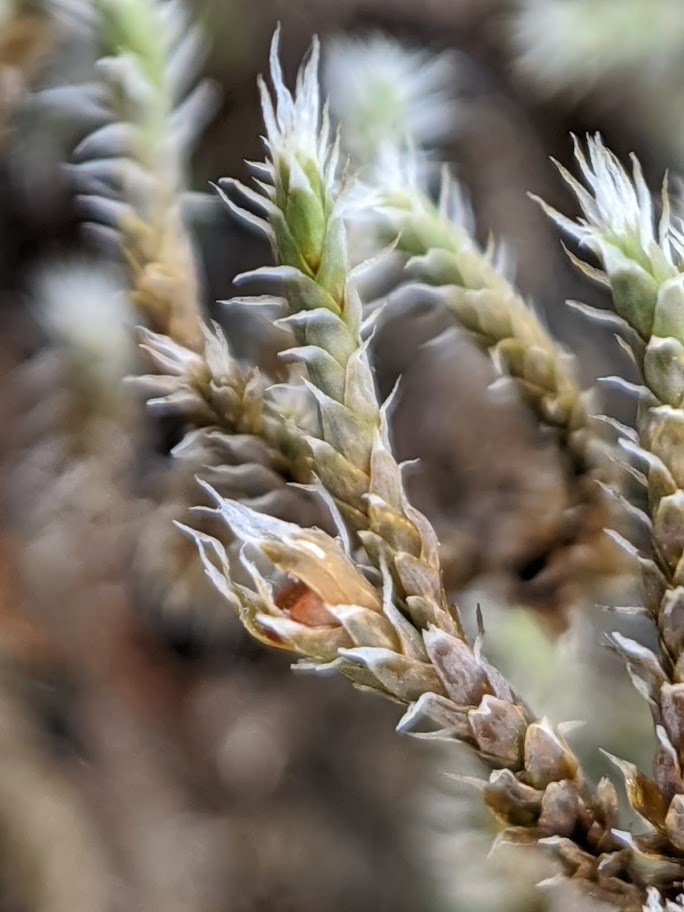Hedwigiaceae
Autoicous or dioicous, rarely synoicous (not in Victoria) or paroicous (not in Victoria). Asexual propagules absent. Mats or tufts on rock, soil or rarely the base of trees (not in Victoria). Stems creeping or erect-ascending, irregularly to pinnately branched, with or without stoloniferous microphyllous stems arising from near base, glabrous or with scattered rhizoids; central strand absent; paraphyllia absent; pseudoparaphyllia filamentous or absent. Leaves arranged around stem facing all directions, monomorphic or stem leaves longer than branch leaves, erect to wide-spreading when moist, appressed to erect-spreading when dry; apex acute to acuminate, hyaline or not, sometimes with a hairpoint; costa absent; margins entire or denticulate to serrate toward apex, revolute, plane or incurved, with or without a border of linear cells; laminal cells quadrate to linear, or fusiform, densely granulate or with one or many simple or branched papillae; alar cells not clearly differentiated or strongly differentiated and coloured, quadrate to rectangular. Acrocarpous, but appearing as if pleurocarpous. Capsules erect, symmetric, exserted or immersed, operculate. Operculum convex or umbonate or rostrate from conic base. Calyptra cucullate or mitrate, glabrous or pilose. Peristome absent.
Worldwide except for Antractica, with three genera and 51 species; three genera and species in Victoria.
Rhacocarpus is anomalous among the Hedwigiaceae, differing from other genera by its branching and filamentous protonema (de Luna 1990), its elongate lamina cells with unique surface ornamentation (Barthlott & Schultze-Motel 1981), the differentiated leaf border, and strongly differentiated alar cells (Crum 1994). In cladistic analyses based on morphological features, Rhacocarpus was well separated from other Hedwigiaceae (de Luna 1995), giving the impression that it is not particularly closely related to Hedwigiaceae. This supports the placement of Rhacocarpus in its own family (Kindberg 1899). However, phylogenetic analyses of a combined dataset of sequences from all genomes show that Rhacocarpus and Braunia are each other’s closest relatives (Buchbender et al. 2014). Consequently, Rhacocarpus is retained here within the Hedwigiaceae. Features that Rhacocarpus has in common with the other Hedwigiaceae include the lack of a peristome and costa. Additionally, both Rhacocarpus and Hedwigia produce tetrahedral spores, which are rare among mosses (Buck 1995).
 Spinning
SpinningBarthlott, W.; Schultze-Motel, W. (1981). Zur Feinstruktur der Blattoberflächen und systematischen Stellung der Laubmoosgattung Rhacocarpus und anderer Hedwigiaceae. Willdenowia 11: 3–11.
Buchbender, V.; Hespanhol, H.; Krug, M.; Sérgio, C.; Séneca, A.; Maul, K.; Hedenäs, L.; Quandt, D. (2014). Phylogenetic reconstructions of the Hedwigiaceae reveal cryptic speciation and hybridisation in Hedwigia. Bryophyte Diversity and Evolution 36.
Buck, W.R. (1995). The systematic position of the moss genus Rhacocarpus. Fragmenta Floristica et Geobotanica 40: 127–131.
Crum, H.A. (1994). Rhacocarpaceae in The Moss Flora of Mexico. Memoirs of the New York Botanical Garden 69: 667.
de Luna, E. (1990). Protonemal development in the Hedwigiaceae (Musci), and its systematic significance. Systematic Botany 15: 192–204.
de Luna, E. (1995). The circumscription and phylogenetic relationships of the Hedwigiaceae (Musci). Systematic Botany 20: 347–373.
Kindberg, N.C. (1899). Studien über die Systematik der pleurokarpischen Laubmoose. Botanisches Centralblatt 77: 49–55.



